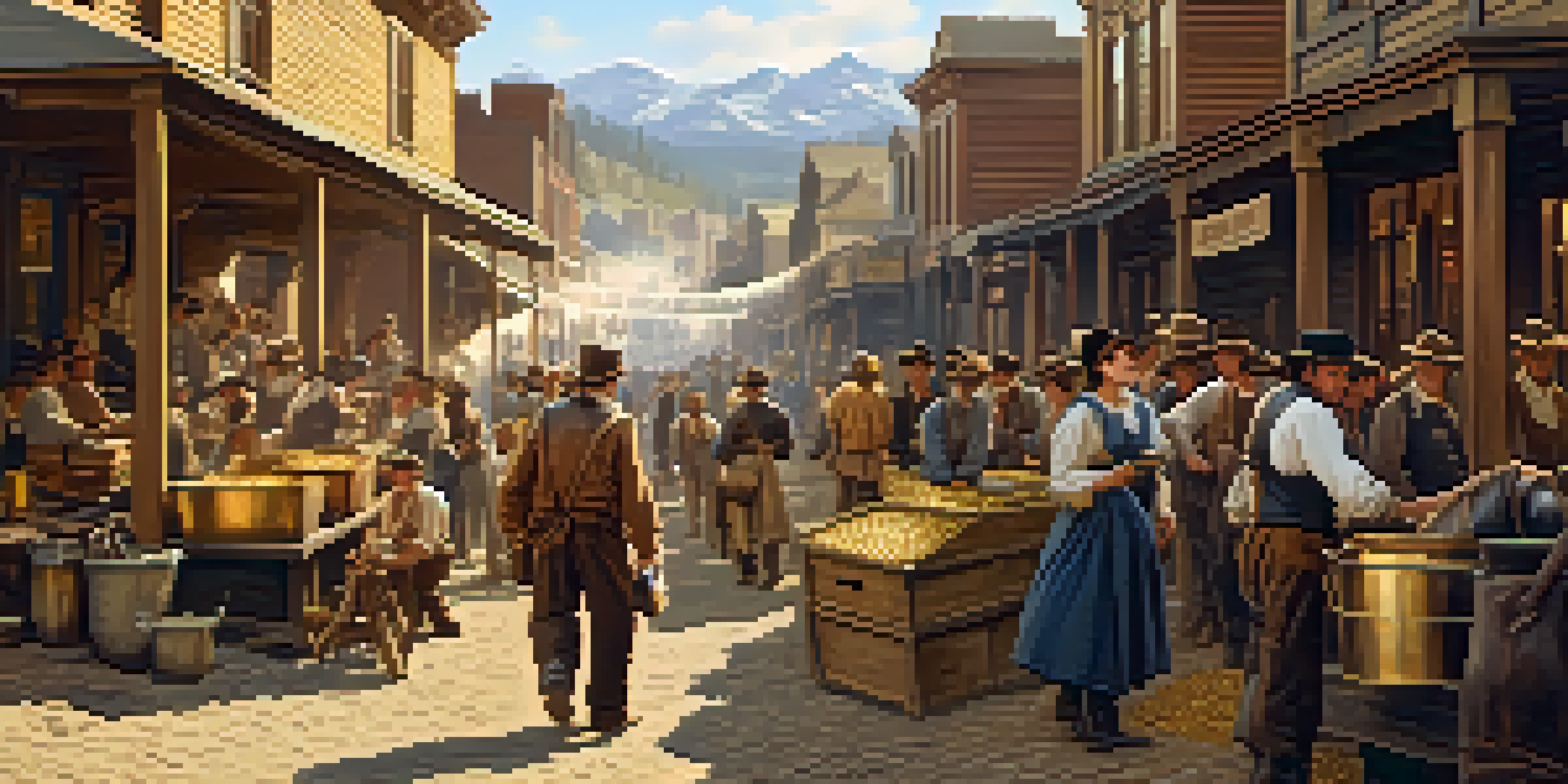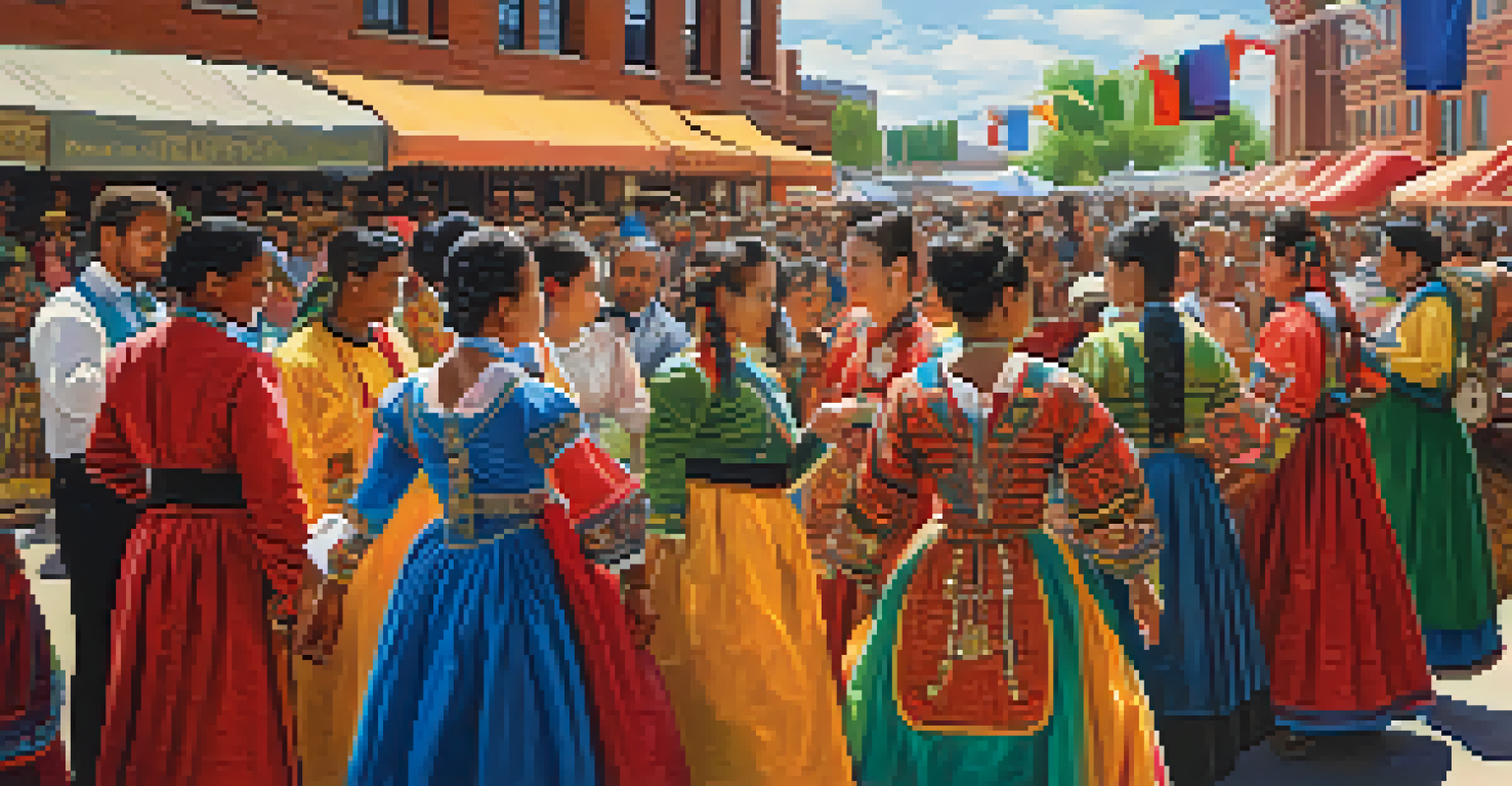Gold Rush: The Catalyst for Denver's Rapid Growth and Change

The Gold Rush Begins: A New Chapter for Denver
In the mid-19th century, the Gold Rush marked a pivotal moment for Denver. It all started in 1858 when gold was discovered in the nearby Rocky Mountains, drawing fortune seekers from all over the country. This event transformed a modest trading post into a bustling settlement almost overnight. The promise of gold was irresistible, and it attracted thousands, eager to strike it rich.
Gold is a treasure, and he who possesses it does all he wishes to do.
As news spread like wildfire, Denver quickly became the epicenter of a gold fever that swept through the West. The influx of miners and entrepreneurs created a vibrant, albeit chaotic, community. Streets that were once quiet began to buzz with the sounds of commerce and ambition. Buildings sprang up, and the city rapidly expanded to accommodate the growing population.
This surge in population not only increased the demand for goods and services but also laid the groundwork for Denver's development. New businesses emerged to cater to miners' needs, from saloons to supply stores. The Gold Rush was more than just a search for wealth; it was the catalyst for Denver’s rapid growth and a shift in its identity.
Economic Boom: How Gold Changed Denver's Landscape
The economic impact of the Gold Rush on Denver was profound. With miners arriving daily, the demand for housing, food, and supplies skyrocketed. Entrepreneurs seized the opportunity, leading to a construction boom that shaped the city's skyline. This rapid development transformed Denver from a small outpost into a thriving urban center, attracting more settlers and businesses.

As the gold poured in, so did the infrastructure improvements. Railroads were built to support the transportation of goods and miners, connecting Denver to other parts of the country. This made it easier to move equipment and supplies, further fueling economic growth. Suddenly, Denver was not just a city rich in gold; it was also rich in opportunity.
Gold Rush Transformed Denver's Economy
The Gold Rush sparked an economic boom in Denver, turning it from a small trading post into a thriving urban center driven by the demands of miners and entrepreneurs.
However, this boom came with its challenges. The rapid growth strained resources and created social tensions. Yet, the city's ability to adapt and innovate during this time laid the foundation for its future prosperity. The Gold Rush was not just an economic flash in the pan; it was a transformative force that reshaped Denver's landscape.
Cultural Melting Pot: Denver's Diverse Inhabitants
With the arrival of miners and settlers from various backgrounds, Denver became a melting pot of cultures. People from different parts of the United States, as well as immigrants from Europe and Asia, flocked to the city in search of opportunity. This diversity enriched the local culture, leading to a unique blend of traditions, languages, and cuisines.
The best way to predict the future is to create it.
As communities formed, they brought their customs and values with them, influencing the social fabric of the city. Festivals celebrating different cultures began to emerge, showcasing the rich heritage of Denver's inhabitants. This cultural exchange not only fostered a sense of belonging but also created a lively atmosphere that defined the city.
However, the diversity also posed challenges, as different groups sometimes clashed over resources and opportunities. Despite these tensions, Denver's growth was fueled by the very diversity that it fostered. The Gold Rush not only transformed the city economically but also culturally, making it a vibrant place to live.
Political Shifts: The Gold Rush and Governance
The rapid population growth during the Gold Rush also necessitated political changes in Denver. As more people settled in the area, the need for organized governance became increasingly apparent. In response, local leaders established a formal government, laying the groundwork for Denver’s future as a city.
This new governance sought to address the needs of its burgeoning population, implementing laws and regulations to maintain order. As a result, city services expanded, and infrastructure improvements became a priority. The establishment of a structured government was essential for managing the challenges that came with rapid growth.
Diverse Cultures Shaped Denver's Identity
As various groups flocked to Denver during the Gold Rush, the city evolved into a cultural melting pot, enriching its social fabric with diverse traditions and customs.
Moreover, the Gold Rush era spurred civic engagement among residents, leading to increased participation in local governance. Citizens became more invested in the political landscape, advocating for their rights and interests. This period marked the beginning of a civic identity that would continue to evolve in Denver.
Environmental Impact: Gold Rush Consequences
While the Gold Rush brought prosperity to Denver, it also had significant environmental consequences. The influx of miners led to widespread resource extraction, which took a toll on the surrounding landscapes. Rivers were diverted, and mountains were blasted in the pursuit of gold, leading to long-lasting ecological damage.
The population boom meant increased waste and pollution, which further strained local ecosystems. As mining operations expanded, the effects on air and water quality became evident, raising concerns among residents. The environmental impact of the Gold Rush is a stark reminder of the costs associated with rapid development.
In recent years, Denver has made efforts to address these environmental challenges. The city has implemented sustainability initiatives aimed at restoring natural habitats and promoting eco-friendly practices. This shift reflects a growing awareness of the need to balance economic growth with environmental stewardship, a lesson that resonates even today.
Legacy of the Gold Rush: Denver's Lasting Changes
The Gold Rush left an indelible mark on Denver, shaping its identity and future. The rapid growth and transformation experienced during this period laid the groundwork for what the city is today. From its vibrant cultural scene to its robust economy, the echoes of the Gold Rush are still felt in Denver.
As the city evolved, it became a hub of innovation and entrepreneurship, attracting diverse industries beyond mining. The spirit of ambition that characterized the Gold Rush era is still alive, driving Denver's growth and development. This legacy continues to inspire new generations of residents and business leaders.
Environmental Challenges Arise from Growth
While the Gold Rush brought prosperity, it also led to significant environmental damage, highlighting the need for sustainable practices in Denver's ongoing development.
Moreover, the Gold Rush serves as a historical touchstone, reminding Denverites of their city’s rich and complex past. The stories of those who ventured to Denver in search of gold are woven into the fabric of the community. This shared history is celebrated and preserved, ensuring that the impact of the Gold Rush is never forgotten.
Conclusion: The Gold Rush as a Catalyst for Change
In conclusion, the Gold Rush was a pivotal catalyst for change in Denver, shaping its economic, cultural, and political landscapes. The influx of people seeking fortune transformed a small settlement into a thriving city, rich in diversity and opportunity. However, this rapid growth also brought challenges that the city continues to navigate today.
The environmental consequences serve as a reminder of the delicate balance between progress and sustainability. As Denver moves forward, it carries the lessons learned from the Gold Rush era, striving to foster growth while being mindful of its impact on the environment and community.

Ultimately, the Gold Rush not only defined a moment in history but also set the stage for Denver's evolution. Its legacy is a testament to the power of ambition and resilience, traits that continue to characterize this vibrant city.